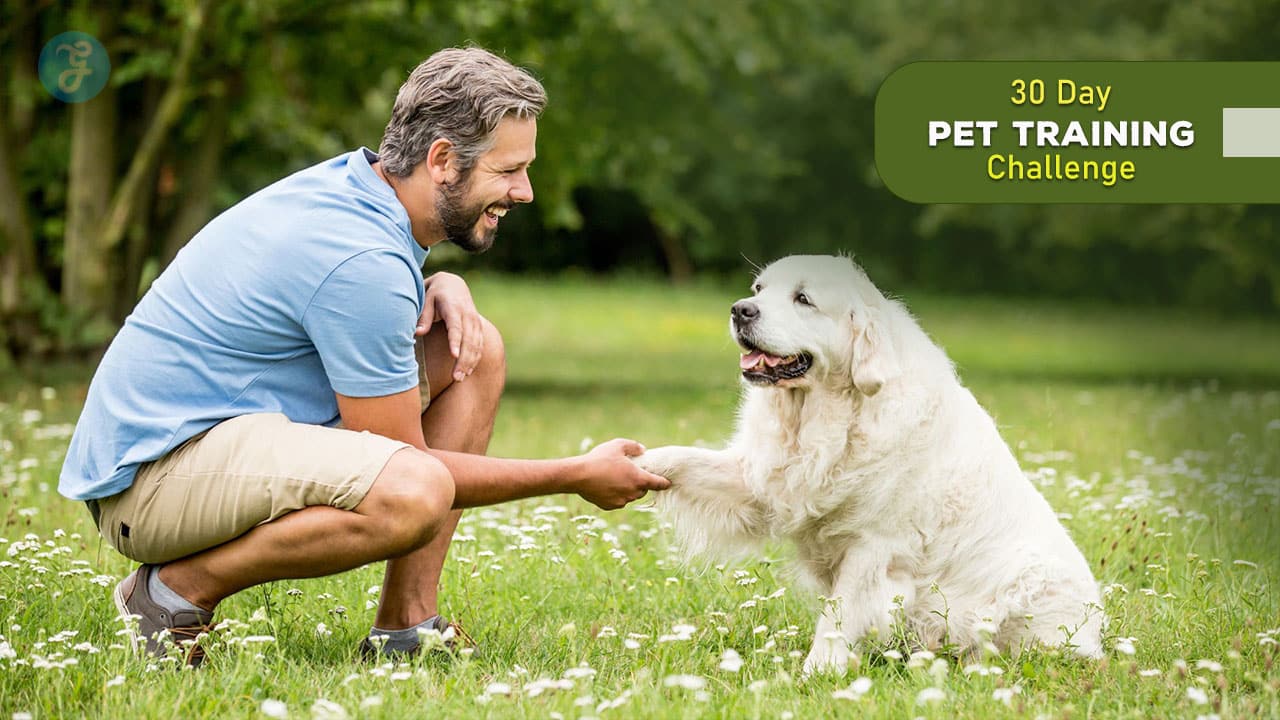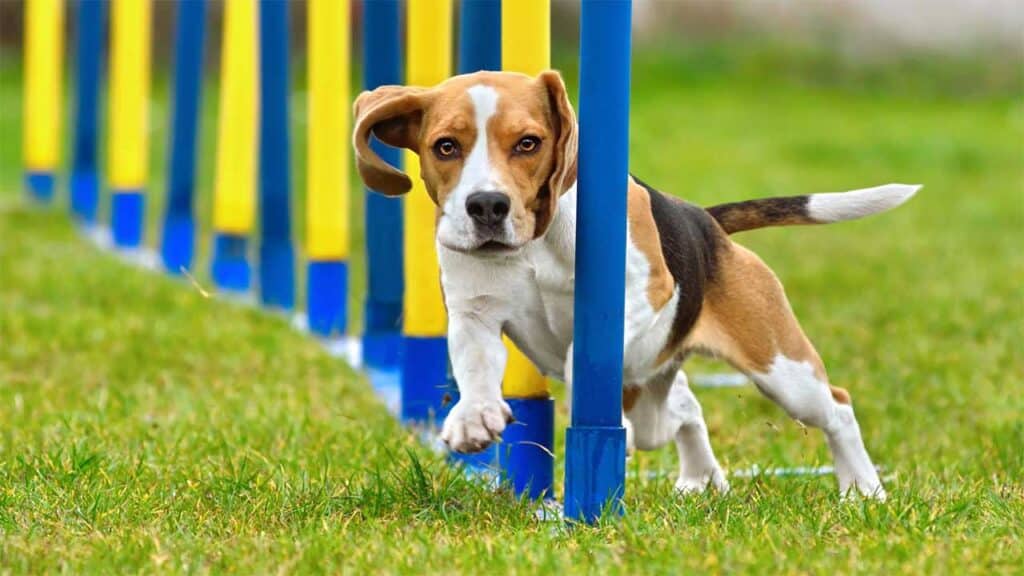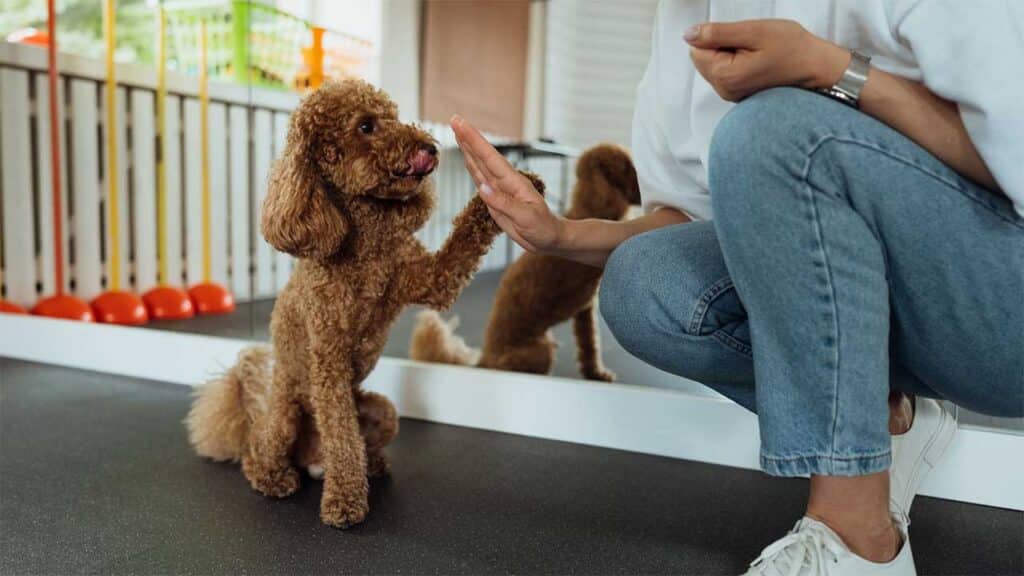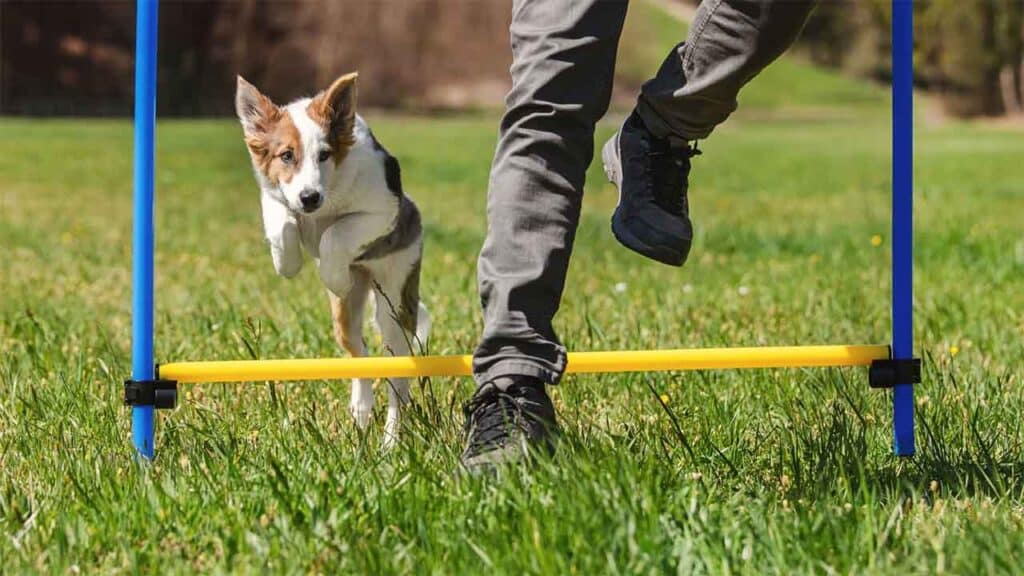Training your pet can be both fun and rewarding. A 30-day challenge is a great way to teach your furry friend new skills. This approach helps you and your pet stay focused and make steady progress.
You can start with basic commands and work up to more advanced ones over the month. This step-by-step method builds a strong bond between you and your pet. It also helps your pet learn and follow instructions better. By the end of the 30 days, you’ll be amazed at how much your pet has learned.
1. Sit
Teaching your dog to sit is a great place to start your 30-day training challenge. It’s a simple command that forms the basis for many other skills.
To begin, hold a treat close to your dog’s nose. Slowly move your hand up and back over their head. As their head follows the treat, their bottom will naturally lower to the ground.
Once your dog is in the sitting position, say “sit” and immediately give them the treat. Repeat this process several times a day for short periods.
Remember to be patient. Some dogs may take longer to learn than others. If your pup doesn’t sit right away, don’t force them. Just try again later.
As your dog gets better at sitting, start using the verbal command “sit” before you show the treat. This helps them associate the word with the action.
Practice in different locations and with various distractions. This helps your dog understand that “sit” means the same thing everywhere.
Once your dog has mastered sitting on command, you can start phasing out treats. Replace them with praise or a quick pat instead.
2. Stay
Teaching your dog to stay is a crucial command. It helps keep them safe and under control in many situations.
To start, have your dog sit. Hold your hand up with your palm facing them, like a stop sign. Say “stay” firmly.
Take a step back. If your dog stays put, praise them and give a treat. If they move, gently guide them back to the starting spot and try again.
Gradually increase the distance between you and your dog. Also, extend the time they must stay before getting a reward.
Practice in different places with various distractions. This helps your dog learn to stay no matter what’s going on around them.
Use the stay command before opening doors, crossing streets, or when guests arrive. It’s a great way to keep your dog calm and in place.
Remember to always release your dog from the stay with a word like “okay” or “free.” This lets them know when it’s fine to move again.
Be patient and consistent. Some dogs learn stay quickly, while others need more time. Keep training sessions short and fun to maintain your dog’s interest.
3. Come
Teaching your dog to come when called is a vital skill. It keeps them safe and makes walks more enjoyable. Start in a quiet area with few distractions.
Say your dog’s name followed by “come” in a happy, upbeat voice. When they move toward you, praise them enthusiastically. Give them a treat when they reach you.
Practice this command multiple times a day. Gradually increase the distance between you and your dog. Add distractions slowly as they improve.
Never punish your dog for coming to you, even if it took a while. This could make them hesitant to come in the future. Always reward and praise them for obeying the command.
Use the command during fun activities. Call your dog to you for meals, walks, or playtime. This helps them associate coming to you with positive experiences.
As your dog gets better, practice in different locations. Try the backyard, park, or during walks. This helps them understand the command applies everywhere.
Remember to be patient. Some dogs learn quickly, while others need more time. Consistent practice and positive reinforcement will help your dog master this important command.
4. Heel
Teaching your dog to heel is a key part of the 30-day challenge. This command helps you keep your pet close during walks.
Start by getting your dog’s attention with a treat. Hold it at your side where they can see it. Say “Heel” and begin walking.
If your dog stays by your side, give them the treat and praise them. If they move away, stop and try again. Practice this for short periods each day.
As your dog improves, gradually increase the walking distance. Use less treats and more verbal praise. This helps your dog understand that staying close is what you want.
Remember to be patient. Some dogs learn quickly, while others need more time. Keep training sessions short and fun to keep your dog engaged.
Try practicing in different places. Start in a quiet area, then move to busier spots as your dog gets better. This helps them learn to heel in various situations.
With consistent practice, your dog will soon be walking nicely by your side. This makes walks more enjoyable for both of you.
5. Down
Teaching your dog to lie down on command is a useful skill. It can help keep them calm in many situations. Start by holding a treat close to your dog’s nose. Slowly lower the treat to the ground. As your dog follows it, their body will naturally lower.
Once your dog is in the down position, say “down” and give them the treat. Praise them warmly. Repeat this process several times. Soon, your dog will start to associate the word with the action.
Practice the command in different places. Try it in your yard, at the park, or even inside stores that allow pets. This helps your dog learn to respond no matter where they are. Be patient and keep sessions short and fun. With time and practice, your dog will master this important command.
6. Off
Teaching your dog the “Off” command is crucial for good behavior. This command tells your dog to stop jumping on people or furniture.
Start by having your dog jump up on you. Say “Off” firmly and step back. When your dog’s paws touch the ground, give a treat and praise.
Practice this daily. Soon, your dog will learn that “Off” means to get down. Use the command when your dog jumps on visitors or tries to climb on the couch.
Be patient and consistent. It may take time, but your dog will get it. Always reward good behavior with treats or praise.
Remember to stay calm when giving the command. Your tone should be firm but not angry. This helps your dog understand what you want.
As your dog improves, try the command in different situations. Use it when your dog tries to grab food from the table or counter. This will help your pet understand that “Off” applies to all unwanted climbing or jumping.
7. Leave It
“Leave it” is a crucial command for your pet’s safety. It teaches your dog to ignore tempting objects or distractions.
Start by holding a treat in each hand. Show your dog one closed fist with a treat inside. Say “leave it” firmly.
Wait for your dog to stop sniffing or pawing at your hand. When they look away or back at you, praise them and give the treat from your other hand.
Practice this exercise several times a day. Gradually increase the difficulty by placing treats on the floor or using more exciting objects.
Remember to always reward your dog with a different treat than the one they’re ignoring. This reinforces that obeying the command leads to something better.
Use “leave it” during walks to prevent your dog from picking up harmful items. It’s also helpful for stopping them from chasing small animals or approaching unfriendly dogs.
Consistency is key. Use the command every time you want your dog to ignore something. With practice, your pet will learn to look to you for guidance in tempting situations.
8. Drop It
Teaching your dog to “drop it” is a key safety command. It can stop your pet from eating something harmful or playing with dangerous objects. This skill also helps prevent resource guarding.
To start, offer your dog a toy they like. Let them play with it for a few seconds. Then, show them a treat and say “drop it” in a clear voice. Most dogs will let go of the toy to get the treat.
As soon as your dog drops the item, praise them and give the treat. Repeat this process several times. Once your dog gets the hang of it, try using the command without showing the treat first.
Practice “drop it” with different objects. Use toys, sticks, and safe household items. This helps your dog understand the command applies to everything, not just one specific toy.
Be patient and keep training sessions short and fun. Aim for 5-10 minutes at a time. With consistent practice, your dog will learn to drop items on command, making your home safer and walks more enjoyable.
9. Watch Me
The “Watch Me” command is a key skill for your pet. It helps build focus and attention. This command is useful in many situations.
To teach “Watch Me,” start in a quiet place. Hold a treat near your eyes. Say “Watch Me” in a clear voice. When your pet looks at you, give the treat right away.
Practice this command often. Gradually increase the time your pet looks at you before giving the treat. Try it in different places with more distractions.
Use “Watch Me” before other commands. It helps your pet pay attention to you. This makes learning other skills easier.
Remember to keep training sessions short and fun. Praise your pet for good efforts. With practice, your pet will look at you on command in any situation.
10. Name Recognition
Teaching your dog to recognize their name is a key part of training. It’s the first step in getting their attention. This skill helps with all other commands.
Start by saying your dog’s name in a happy voice. When they look at you, give them a treat. Do this many times a day. Soon, your dog will connect their name with good things.
Try saying their name when they’re not looking at you. Wait for them to turn. When they do, reward them right away. This teaches them to respond even when distracted.
Practice in different places. Use their name at home, in the yard, and on walks. This helps your dog understand to respond no matter where they are.
Keep sessions short and fun. Use lots of praise and treats. Your dog will learn that paying attention to you is rewarding.
With time and practice, your dog will quickly turn to you when they hear their name. This skill forms the base for all future training.
11. Loose Leash Walking
Loose leash walking is a vital skill for you and your dog. It makes walks more enjoyable for both of you. Your dog can explore and sniff without pulling you around.
To start training, practice in a quiet area with few distractions. Hold treats in your hand and encourage your dog to walk beside you. When the leash is slack, reward your dog with praise and treats.
If your dog pulls, stop walking. Wait for them to come back to you or loosen the leash. Once they do, start walking again. This teaches them that pulling doesn’t get them where they want to go.
Consistency is key. Practice loose leash walking for short periods every day. Gradually increase the time and add more distractions as your dog improves.
Remember to be patient. Some dogs may take 6-18 months to master this skill. Keep training sessions positive and fun. With time and practice, your dog will learn to walk calmly by your side.
12. Recall
Recall is a vital command for your dog’s safety and your peace of mind. It means your dog comes to you when called, no matter what’s happening around them.
Start teaching recall in a quiet place with few distractions. Use a happy, excited voice to call your dog’s name followed by “come!
When your dog reaches you, give lots of praise and a tasty treat. Make coming to you the best thing ever!
Practice recall several times a day in short sessions. Gradually increase the distance between you and your dog.
Once your dog is good at recall indoors, move to your backyard. Then try quiet outdoor areas like an empty park.
Add distractions slowly. Have a friend stand nearby or toss a toy as you call your dog. Reward heavily when they choose to come to you instead.
Never punish your dog for coming to you, even if they took a while. This might make them hesitant to come next time.
Use recall for good things only. Don’t call your dog to give medicine or end playtime. Go to them instead for those tasks.
With patience and practice, your dog will learn that “come” means run to you fast. This skill could save their life one day.
13. Touch (Hand Targeting)
Touch or hand targeting is a fun and useful command to teach your dog. It’s a simple skill where your dog learns to touch their nose to your hand on cue.
To start, hold your palm out flat near your dog’s nose. When they sniff or touch it, say “yes!” and give a treat. Repeat this several times.
Next, add the word “touch” just before you present your hand. Your dog will start to connect the word with the action. Practice in short sessions throughout the day.
Once your dog gets the hang of it, try moving your hand to different positions. You can also increase the distance between you and your dog.
Touch has many practical uses. You can use it to guide your dog through doorways or into their crate. It’s also great for redirecting attention away from distractions.
This command helps build confidence in shy dogs. It can make them more comfortable with handling and new objects. You can even teach your dog to target other items besides your hand.
Remember to keep training sessions short and fun. Always end on a positive note with lots of praise for your dog’s efforts.
14. Wait
Teaching your dog to “wait” is a valuable skill. This command helps keep your pet safe and well-behaved in many situations.
To start, have your dog sit or stand near a door. Hold up your hand in a “stop” signal and say “wait” in a clear voice. Take a step back. If your dog stays put, praise them and give a treat.
Gradually increase the distance and time your dog waits. Practice in different spots around your home. Try it before meals, when getting in or out of the car, or at street corners.
Remember to stay patient and consistent. Some dogs learn quickly, while others may need more time. Keep training sessions short and fun to maintain your pet’s interest.
With practice, your dog will learn to pause and look to you for permission before moving forward. This command can prevent your pet from dashing out doors or into unsafe areas.
15. Shake Hands
Teaching your dog to shake hands is a fun and impressive trick. It’s also a great way to bond with your pet.
Start by having your dog sit. Hold a treat in your closed hand near their paw. Most dogs will naturally paw at your hand to get the treat.
When they touch your hand with their paw, say “shake” and give them the treat. Repeat this several times.
Next, try holding out your empty hand and saying “shake.” If your dog lifts their paw, praise them and give a treat from your other hand.
Practice this daily for short sessions. Soon, your dog will offer their paw whenever you say “shake” or hold out your hand.
You can make it more challenging by asking for different paws. Say “other paw” or use hand signals to mix it up.
Remember to keep training sessions short and fun. Always end on a positive note with lots of praise.
With patience and consistency, your dog will be shaking hands like a pro in no time!
16. Spin
Teaching your dog to spin is a fun and easy trick. It’s a great way to add some excitement to your training routine. You can start with treats to lure your dog into a circular motion.
Hold a treat close to your dog’s nose. Slowly move your hand in a circle, guiding your dog to follow. As your dog completes the spin, say “spin” and give the treat. Repeat this process several times.
Once your dog gets the hang of it, try using just the hand motion without the treat. Say “spin” as your dog turns. Reward with praise and a treat after they finish the spin.
You can teach your dog to spin in both directions. Use “spin” for one way and “twirl” for the other. This gives your dog a mental workout and improves their coordination.
Practice spin in short sessions. Keep it fun and upbeat. Your dog will soon be spinning on command, showing off their new trick to friends and family.
17. Roll Over
Teaching your dog to roll over is a fun and impressive trick. It’s a great way to bond with your pet and show off their skills to friends and family.
Start with your dog in the “down” position. Hold a treat close to their nose, then slowly move it towards their shoulder. This will encourage them to roll onto their side.
As your dog follows the treat, continue moving it in a circular motion. This will guide them to roll all the way over. Once they complete the roll, give lots of praise and the treat.
Use the command “roll over” as your dog performs the action. Repeat this process several times a day for short sessions. Be patient, as some dogs may take longer to learn this trick than others.
If your dog struggles, break the trick down into smaller steps. Reward them for lying on their side first, then gradually work up to the full roll. Always keep training sessions positive and fun.
Practice in different locations to help your dog generalize the command. Soon, they’ll be rolling over on cue, impressing everyone with their new skill.
18. Play Dead
Teaching your dog to play dead is a fun and impressive trick. It’s a great way to bond with your pup and show off their skills to friends and family.
Start with the basics. Make sure your dog knows how to sit and lie down on command. These skills form the foundation for more advanced tricks.
Next, get your dog to lie on their side. You can gently guide them into position with a treat. Once they’re lying down, give the command “play dead” or “bang” while making a finger gun gesture.
Reward your dog when they stay in position. Use treats and praise to reinforce the behavior. Gradually increase the time they need to stay still before getting the reward.
Practice regularly but keep sessions short. A few minutes each day is better than long, tiring sessions. Be patient and consistent in your training approach.
As your dog improves, add distance between you. Try giving the command from further away or while standing up. This helps solidify their understanding of the trick.
Remember to always end training on a positive note. Give lots of praise and maybe a special treat when your dog does well. Soon, you’ll have a star performer on your hands!
19. Speak
Teaching your dog to speak on command can be a fun and useful trick. It gives you control over when your dog barks, which can help reduce unwanted barking.
Start by getting your dog excited with a toy or treat. When they naturally bark, say “Speak” and give them the reward. Repeat this process several times.
Next, try saying “Speak” before they bark. Wait for them to make a sound, then reward them right away. Be patient, as some dogs may take longer to understand.
Practice in short sessions to keep it fun. Gradually increase the time your dog needs to wait before getting the reward. This helps build their self-control.
Remember to also teach a “Quiet” command. This balances out the “Speak” command and gives you more control over your dog’s barking.
Use “Speak” sparingly to avoid encouraging excessive barking. It’s best used for specific situations, like alerting you to visitors or during playtime.
With practice, your dog will learn to bark on cue. This trick can impress friends and family, and it’s a great way to bond with your pet.
20. Quiet
Teaching your dog the “Quiet” command is crucial for controlling excessive barking. This skill helps create a peaceful home environment and maintains good relationships with neighbors.
Start by letting your dog bark a few times. Then, say “Quiet” in a firm but calm voice. When your dog stops barking, even for a moment, praise them and offer a treat.
Repeat this process regularly. Gradually increase the time between the dog stopping and receiving the reward. This helps reinforce the behavior.
Use the command in different situations. Practice when your dog barks at the doorbell, passing cars, or other dogs. Consistency is key to success.
Remember to stay patient. Some dogs may take longer to learn this command than others. Keep training sessions short and positive to maintain your dog’s interest.
Once your dog masters “Quiet” indoors, practice outdoors too. This helps generalize the command to various environments. With time and practice, your dog will learn to stop barking on command.
21. Go to Bed
Teaching your dog to “go to bed” is a useful command. It helps your pet settle down when needed. This skill comes in handy during meal times or when guests visit.
Start by choosing a specific spot for your dog’s bed. Make sure it’s comfortable and easily accessible. Use a clear command like “go to bed” or “place” every time.
Lead your dog to the bed with a treat. Reward them when they step onto it. Repeat this process several times. Gradually increase the distance between you and the bed.
Once your dog understands, add a stay command. Ask them to stay on the bed for longer periods. Always praise and reward good behavior. This reinforces the positive association with the bed.
Practice in different situations. Try when your dog is excited or distracted. This helps them learn to obey even when it’s not easy. Be patient and consistent with your training.
Remember to keep training sessions short and fun. End on a positive note to keep your dog eager to learn more.
22. Jump
Teaching your dog to jump on command can be a fun and useful trick. It’s great for agility training and can help your dog stay active and fit.
Start with a low obstacle like a small hurdle or a stick on the ground. Hold a treat above it to encourage your dog to go over. Use a clear command like “Jump” or “Over” as they cross.
Reward your dog immediately when they complete the jump. Praise them enthusiastically and give them the treat. Repeat this process several times until your dog starts to associate the command with the action.
Gradually increase the height of the obstacle as your dog becomes more confident. Be careful not to make it too high too quickly. You don’t want to risk injury or discourage your dog.
Practice the jump command in different locations. This helps your dog understand that the command applies anywhere, not just in one specific spot.
Remember to keep training sessions short and fun. End on a positive note with a successful jump and lots of praise. With patience and consistency, your dog will soon be jumping on command like a pro.
23. High Five
Teaching your dog to high five is a fun and impressive trick. It’s a great way to bond with your pet and show off their skills to friends and family.
Start by having your dog sit. Hold a treat in your closed hand near their nose. Many dogs will naturally lift a paw to try to get the treat. When they do, say “High five!” and give them the treat.
If your dog doesn’t lift their paw on their own, gently tap their paw to encourage them. Praise and reward any movement towards your hand. Repeat this process several times a day.
As your dog gets better, start holding your hand higher. Eventually, you can present an open palm for them to touch with their paw. Always use the “High five” command and reward them for success.
Practice in short sessions to keep it fun. Once your dog masters the trick, you can phase out treats and use praise instead. Soon you’ll have an adorable party trick to show off your pup’s skills.
24. Fetch
Fetch is a fun game that also teaches your dog important skills. It combines obedience, retrieval, and bonding. To start teaching fetch, choose a toy your dog loves.
Show your dog the toy and get them excited about it. Toss it a short distance and encourage them to go after it. When they pick it up, call them back to you.
If your dog doesn’t bring the toy back, don’t chase them. Instead, show them another toy or treat to lure them to you. Once they come, praise them and give them the reward.
Use a command like “bring it” or “fetch” when you throw the toy. This helps your dog understand what you want. When they return with the toy, say “drop it” and offer a treat in exchange.
Practice in short sessions to keep it fun. Gradually increase the distance you throw the toy as your dog improves. Always end on a positive note with lots of praise.
Some dogs may need extra encouragement to fetch. Try using different toys to find what motivates them most. You can also play in a hallway or enclosed area to limit distractions.
Remember to be patient. Some dogs learn fetch quickly, while others may take more time. Keep sessions upbeat and rewarding to build your dog’s enthusiasm for the game.
25. Take It
The “Take It” command teaches your dog to gently pick up objects with their mouth. This skill is useful for everyday tasks and games.
Start with a favorite toy or treat. Hold it in front of your dog’s nose, but don’t let them grab it yet. Say “Take It” in a clear, upbeat voice.
When your dog reaches for the item, praise them and let go. If they’re hesitant, wiggle the object to make it more enticing.
Practice this several times a day. Use different objects to keep things interesting. Try soft toys, balls, or even lightweight household items.
Gradually increase the difficulty. Place the object on the ground instead of holding it. Ask your dog to take it from there.
Remember to reward your dog each time they successfully take an item. This reinforces the behavior and makes learning fun.
As your dog improves, add a release command like “Drop It” or “Give.” This teaches them to let go of the object when asked.
With patience and practice, your dog will master the “Take It” command. It’s a great way to engage their mind and strengthen your bond.
26. Find It
“Find It” is a fun and useful command for your pet. It helps sharpen their problem-solving skills and taps into their natural instincts. This game-like activity can also tire out energetic dogs mentally and physically.
To teach “Find It,” start with a favorite toy or treat. Show it to your pet, then toss it a short distance away. Say “Find It” and let them retrieve the item. Praise them when they do.
As your pet gets better, increase the difficulty. Hide the object in tougher spots around the house or yard. You can even use this command for practical purposes, like finding lost items or people.
Remember to keep training sessions short and fun. Use lots of praise and rewards to keep your pet motivated. With practice, your furry friend will become an expert at the “Find It” game.
27. Stand
The “stand” command teaches your dog to rise up on all four legs from a sitting or lying position. This useful skill helps during grooming, vet visits, and other situations.
To start training, have your dog sit or lie down. Hold a treat close to their nose, then slowly move it forward and up. As your dog follows the treat, they’ll naturally stand up.
Say “stand” as they rise, then give them the treat and praise. Repeat this process many times. Gradually phase out the lure and just use the verbal cue.
Practice in different places and with various distractions. Ask your dog to stand from both sitting and lying positions. You can also teach a hand signal, like moving your palm up.
Be patient and keep sessions short and fun. Reward your dog’s efforts, even if they don’t stand perfectly at first. With practice, they’ll learn to stand quickly on command.
28. Backup
Teaching your dog a backup command can be really useful. It helps your pet move backwards on cue. This skill comes in handy in tight spaces or when you need your dog to give someone space.
To start, stand in front of your dog. Take a small step towards them. Most dogs will naturally take a step back. As soon as they do, say “backup” and give them a treat.
Keep practicing this move. Gradually increase the number of steps your dog takes backwards. Use a hand signal along with the verbal cue. You can hold your palm out facing your dog and move it towards them.
Remember to be patient. Some dogs might find this tricky at first. Always reward even small progress. With time and practice, your dog will learn to back up on command.
This skill can be really helpful in everyday situations. It can keep your dog from crowding doorways or jumping on people. It’s also a fun trick to show off to friends and family.
29. Go Around
“Go around” is a fun and useful command for your pet. It teaches them to circle an object or person. This skill can come in handy in many situations.
To start, choose an object like a chair or cone. Hold a treat in your hand and lure your pet around the object. As they follow, say “go around” clearly.
When your pet completes the circle, give them the treat and praise. Repeat this several times. Gradually reduce the lure and use just the verbal cue.
Practice with different objects and in various locations. This helps your pet understand the command applies to any situation. You can even teach them to go around you!
As your pet gets better, increase the distance between you and the object. Try giving the command from farther away. This builds their understanding and response.
Remember to keep training sessions short and fun. Aim for 5-10 minutes at a time. Always end on a positive note with success and praise.
30. Under
Teaching your dog the “under” command is useful for many situations. This command tells your dog to go beneath an object. It can help when you need your dog to stay out of the way.
To start, choose a table or chair. Hold a treat and lure your dog under the object. Say “under” as they move. Give the treat when they’re fully underneath.
Practice this a few times. Then try without the lure. Point under the object and say “under.” Reward your dog when they go beneath it on their own.
Make it harder by using different objects. Try park benches or outdoor tables. This helps your dog understand “under” means to go beneath things, not just one specific item.
Use “under” when you’re out walking. It can keep your dog safe if a bike or stroller passes by. It also gives them a job to do when you stop to chat with someone.
Remember to praise your dog each time they follow the command. This keeps them excited to learn and obey. With practice, your dog will master the “under” command in no time.
Understanding Pet Behavior
Pet behavior stems from instincts, learning, and environment. Knowing why animals act certain ways helps you train them better. Let’s look at the basics of animal psychology and common behavior issues.
The Basics of Animal Psychology
Animals learn through rewards and consequences. Positive reinforcement works best for training. Give treats or praise when pets do what you want. This makes them more likely to repeat good actions.
Pets also learn by watching others. They pick up habits from people and other animals around them. Your mood and actions affect your pet’s behavior too.
Animals have natural instincts that shape how they act. Dogs like to chase moving things. Cats enjoy climbing and scratching. Understanding these drives helps you work with your pet’s nature.
Identifying Common Behavioral Issues
Many pet problems come from boredom, fear, or a need for attention. Chewing, barking, and scratching often mean your pet needs more exercise or mental stimulation. Try puzzle toys or longer walks.
Aggression can stem from fear or feeling threatened. Watch for signs like growling or hissing. Give your pet space and work on building trust slowly.
Separation anxiety shows up as destructive behavior when you’re gone. Start with short absences and gradually increase time away. Leave toys to keep your pet busy.
Housetraining accidents may mean your pet needs more frequent potty breaks. Stick to a regular schedule and use lots of praise for success.
Starting with Basic Commands
Basic commands form the foundation of pet training. They help build a strong bond between you and your pet while teaching essential skills for good behavior.
Sit and Stay: The Foundations
Start with “sit.” Hold a treat close to your pet’s nose, then move it up and back. As their head follows, their bottom will lower. Say “sit” and give the treat when they do. Practice often.
Next, teach “stay.” Ask your pet to sit, then say “stay” while holding your hand out. Take a step back. If they stay, praise and treat them. Slowly increase the distance and time.
Use these commands before meals, walks, or playtime. This helps your pet learn that good behavior leads to rewards.
Teaching Your Pet to Respond to Its Name
Choose a short, clear name for your pet. Say it in a happy voice. When they look at you, give a treat and praise. Do this many times a day.
Call your pet’s name when they’re not looking at you. Reward them when they turn to you. Practice in different places with more distractions as they improve.
Make the name fun by using it for good things like meals or walks. Never use it for scolding. This builds a positive link to their name.
Progressing to Intermediate Commands
As your pet gains confidence with basic commands, it’s time to level up. Intermediate commands build on foundational skills and help your pet become more responsive and well-behaved.
Heel and Follow
Teaching your dog to heel is a key skill for pleasant walks. Start in a quiet area with few distractions. Hold treats at your side and say “heel” as you begin walking. Reward your pet when they stay by your side. If they pull ahead, stop and wait for them to return. Practice in short sessions, gradually increasing distance and adding distractions.
For “follow,” use a treat to lure your pet. Move in different directions, rewarding them for staying close. Add the verbal cue “follow” as they get better. Practice indoors first, then move outside. Vary your speed and direction to keep it challenging.
Mastering the Recall Command
A strong recall can keep your pet safe in emergencies. Start in a low-distraction area. Call your pet’s name followed by “come” in a happy voice. When they reach you, give lots of praise and a high-value treat. Practice several times a day in short sessions.
Gradually increase distance and add distractions. Use a long leash for safety when practicing outdoors. Never punish your pet for coming to you, even if it took a while. This might make them hesitant to come in the future. Make coming to you always positive and rewarding.
Advanced Command Training
Advanced command training takes your pet’s skills to new heights. It builds on basic obedience and teaches complex behaviors that can impress and amaze.
Off-Leash Training Techniques
Off-leash training lets your pet move freely while still following your commands. Start in a safe, enclosed area. Use a long leash at first, then slowly remove it. Reward your pet for staying close without being told. Practice recall often, making it fun with treats and praise. Teach a “watch me” command to keep your pet’s focus on you. Use hand signals along with voice commands. This helps when your pet is far away. Be patient and consistent. Off-leash skills take time to master.
Complex Tricks and Behaviors
Complex tricks show off your pet’s smarts and skills. Teach your dog to bring you specific items by name. Start with two toys and build up. Use the “take it” and “drop it” commands as a base. Try teaching your pet to balance treats on their nose. This takes focus and self-control. Spin-and-twirl tricks are fun and easy to learn. Use a treat to lure your pet in a circle. Add a command word as they get it. For cats, try teaching them to jump through hoops or run obstacle courses. Always keep training sessions short and fun.
Consistency and Patience
Training your pet takes time and effort. Sticking to a routine and understanding how your pet learns are keys to success. Let’s look at how to stay on track and work with your pet’s learning style.
Maintaining Training Routine
Set a daily training schedule. Pick times when you and your pet are alert. Short, frequent sessions work best. Aim for 5–10 minutes, 2-3 times a day.
Use the same cues each time. If you say “sit,” don’t switch to “sit down.” This keeps things clear for your pet.
Make training fun. Use treats, toys, and praise. Your pet will look forward to sessions.
Keep going, even if progress seems slow. Small steps add up over time.
Understanding Your Pet’s Learning Curve
Every pet learns at their own pace. Some catch on quickly, others need more time. Don’t compare your pet to others.
Watch for signs your pet is getting tired or frustrated. Take breaks when needed.
Celebrate small wins. Did your dog sit for one second? That’s progress!
Be patient with setbacks. Your pet might forget commands sometimes. This is normal. Just go back and practice more.
If your pet struggles with a task, make it easier. Then slowly make it harder as they improve.
Remember, learning is a process. Your pet wants to please you. With time and practice, they’ll get there.
Final Thoughts
Embarking on a 30-day pet training challenge is a rewarding journey that strengthens the bond between you and your pet while transforming their behavior.
By breaking down the training into daily, manageable tasks, you ensure steady progress and build a solid foundation for advanced commands. Consistency, patience, and positive reinforcement are keys to success.
As you guide your pet through this challenge, you’ll not only teach them new skills but also deepen your understanding of their unique learning style.
By the end of the 30 days, you’ll be amazed at the progress your pet has made, setting the stage for a lifetime of good behavior and a closer relationship.









































